Slip Stitch Dishtowels
These dishtowels look really complicated to make, don’t they? I love that because, just like you want hard things to look easy, it’s a great coup to make easy things look difficult!

These three stitch patterns all come from Barbara Walker’s classic Treasury of Knitting Patterns and are created by the simple technique of hiding yarns behind slipped stitches. There’s no tricky stranding or two-hand knitting or even issues of tension; there’s just the easy matter of slipping stitches and watching as amazing patterns emerge!
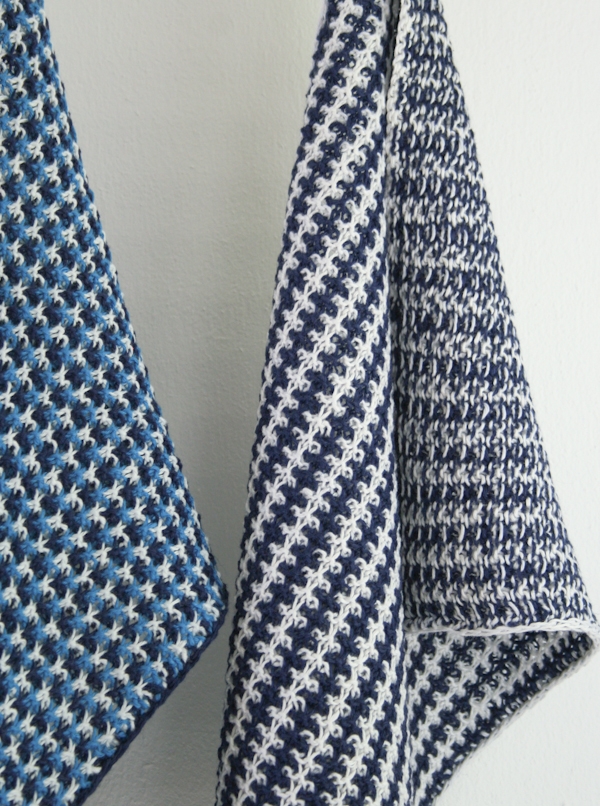
Slip stitch color patterns are terrific for scarves (check out Laura’s gorgeous Reversible Stripes Scarf), sweaters, blankets and even dishtowels. For these, I looked for patterns that would evoke traditional kitchen textiles: no-nonsense designs with the geometry of vintage linens.
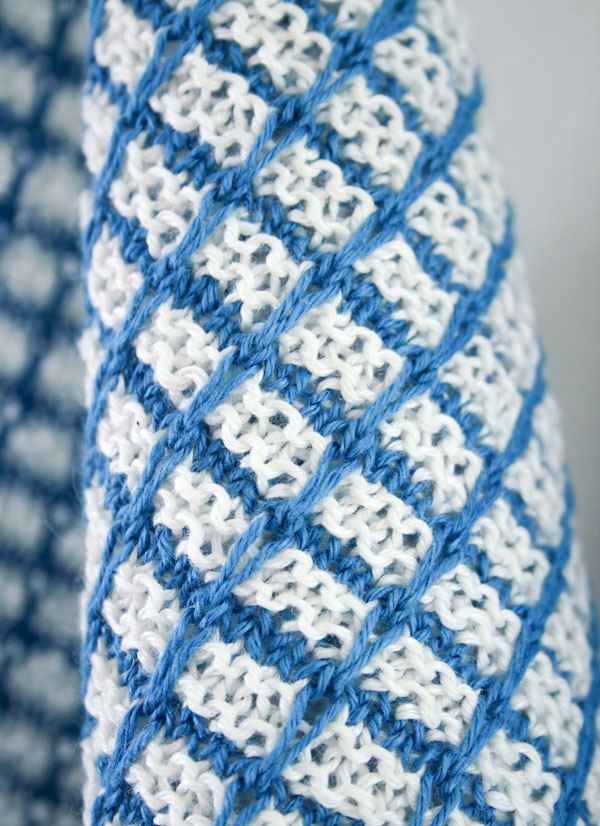
And for a yarn that would match these hard-working stitch patterns I chose Louet’s Euroflax 100% linen. As tough and absorbent as any fiber around, linen is a great friend to have over your shoulder when you’re cooking up something good!
Happy slip stitching! -Whitney
Update: New Materials
June 28, 2017
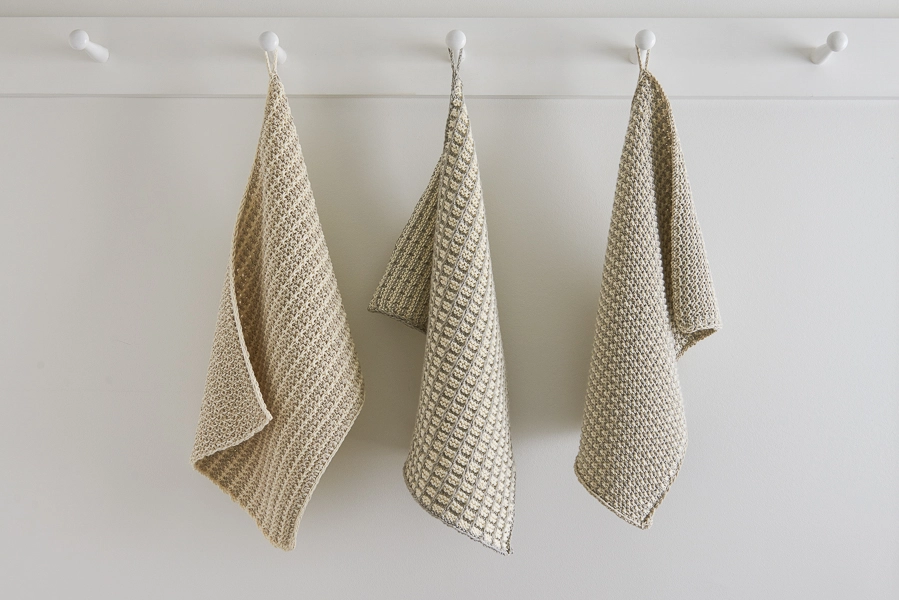
In our Cotton Pure, these Dishtowels are a bit hefty and a lot soft. They’re also absorbent and totally beautiful! For more information and additional photos, be sure to check out our new post!
Update: New Yarn
July 16, 2021
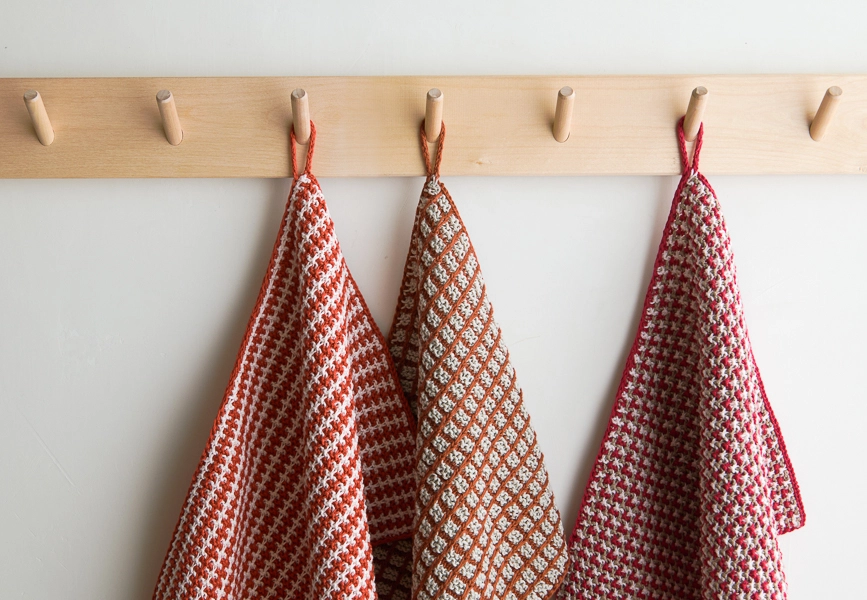
Perfect for home and hitch, our Slip Stitch Dishtowels are as strong as an ox, machine washable, and absorbent, too! For this iteration, we used our new Blackbird Linen. Like the wing of a blackbird catching the early morning light, our newest yarn shines with an understated elegance that belies its hard-working character. Click here to read more!
Designed by Purl Soho designer, Whitney Van Nes.
Share your progress and connect with the community by tagging your pics with #PurlSoho, #PurlSohoBusyHands, and #PurlSohoSlipStitchDishtowels. We can’t wait to see what you make!
Materials
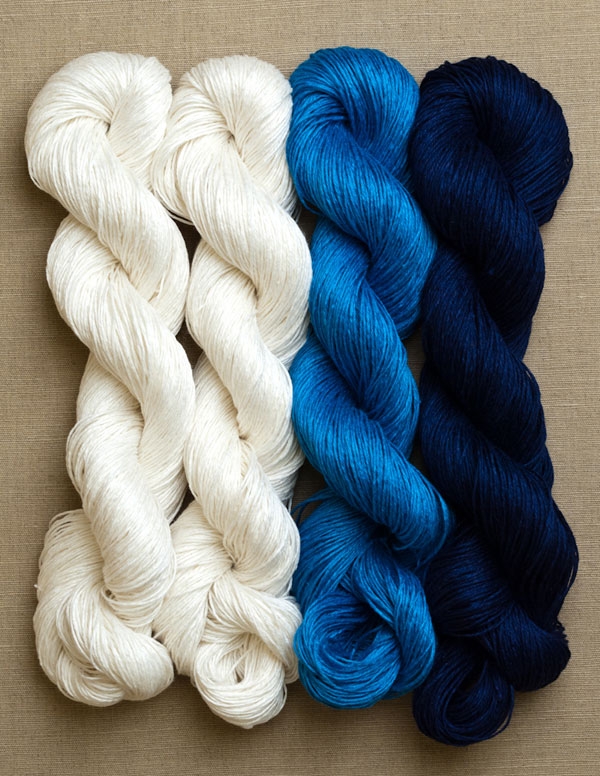
- 4 skeins of Louet’s Euroflax, 100% linen. Each skein is approximately 270 yards/ 100 grams.
- Color A: 2 skeins of Cream; approximately 390 yards required.
- Color B: 1 skein of Caribbean Blue; approximately 225 yards required. (this color has since been discontinued)
- Color C: 1 skein of Navy; approximately 240 yards required.
Note: This is enough yarn to make these three dishtowels plus one more.
You will also need…
- US 3 (3.25 mm) straight or 24-inch circular needles
- If using straight needles: Two US 3 double pointed needles for I-Cord
Gauge
23 stitches = 4 inches in stockinette stitch
Size
Finished Dimensions: 11¼ x 17¼ inches
Notes
- Slip all stitches purlwise.
- When changing colors, carry the new yarn up the selvedge in front of the old yarn. In this photo the Navy yarn is the “new yarn” about to knit the first stitch.
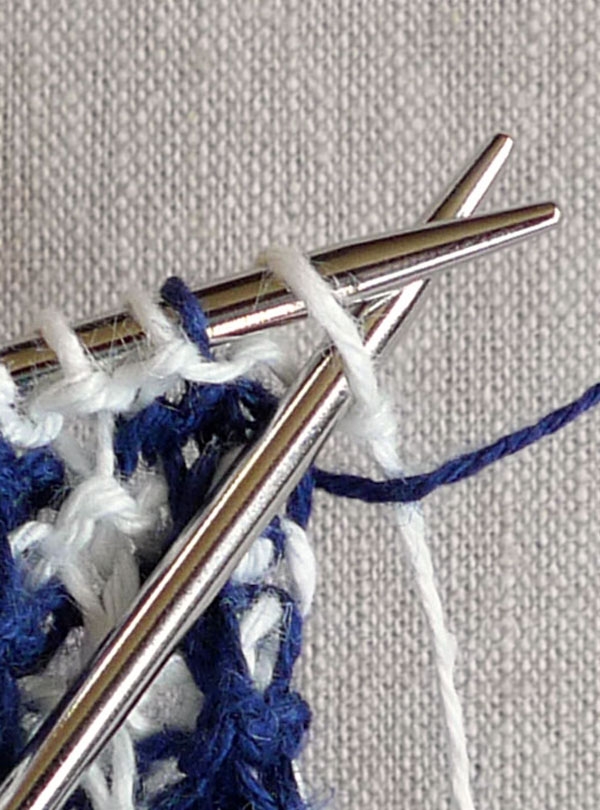
Patterns
Three-and-One Tweed Pattern
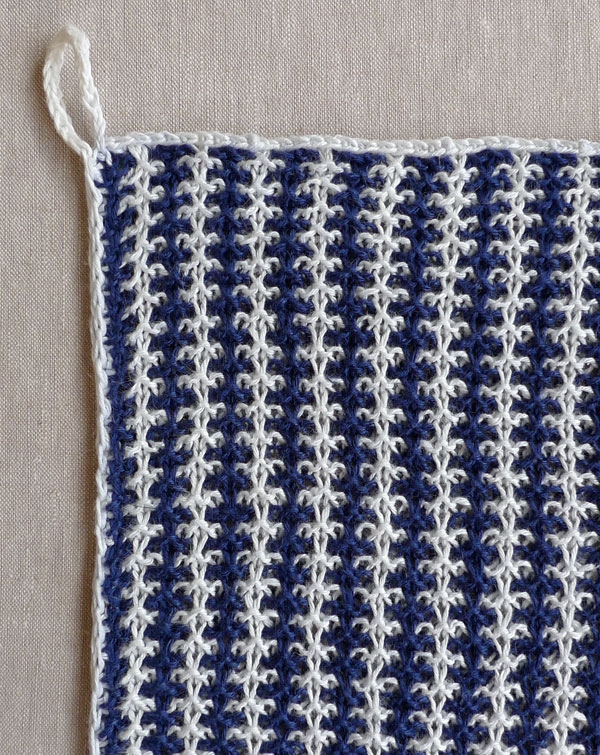
With Color A, cast on 75 stitches. We used a basic Long Tail Cast On.
Row 1 (wrong side): Purl.
Row 2 (right side): With Color C, k3, *slip 1 with yarn in back (wyib), k3, repeat from * to end of row.
Row 3: With Color C, slip 1 wyib, k2, *slip 1 with yarn in front (wyif), k3, repeat from * to end of row.
Row 4: With Color A, k1, *slip 1 wyib, k3, repeat from * to last 2 stitches, slip 1 wyib, k1.
Row 5: With Color A, slip 1 wyib, *slip 1 wyif, k3, repeat from * to last 2 stitches, slip 1 wyif, k1.
Repeat Rows 2 – 5 until piece measures 17 inches, ending with a Row 3.
Cut Color C.
Next Row (right side): With Color A, knit to last 2 stitches, k2 onto a double pointed needle.
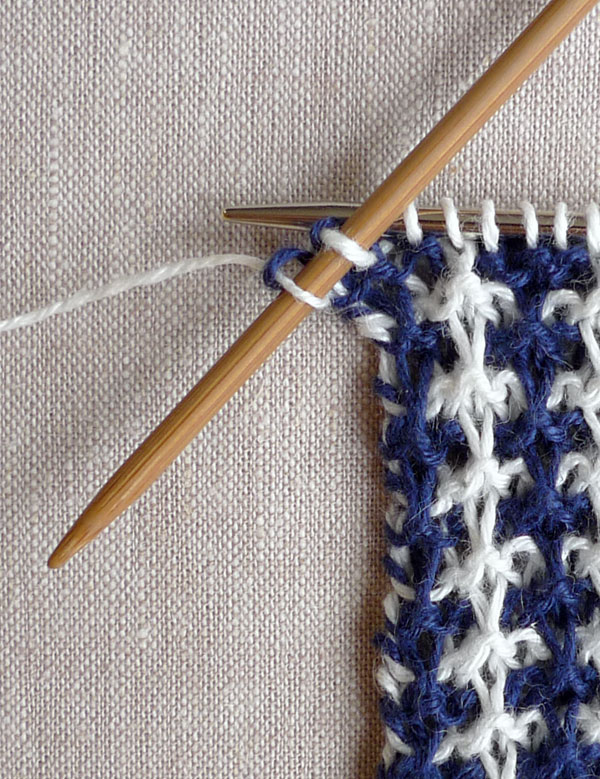
Finish
With the right side facing you, work an I-cord on those last 2 stitches until the cord measures 3 inches from its base.
Work the last row as a k1, slip 1 wyib, yo.
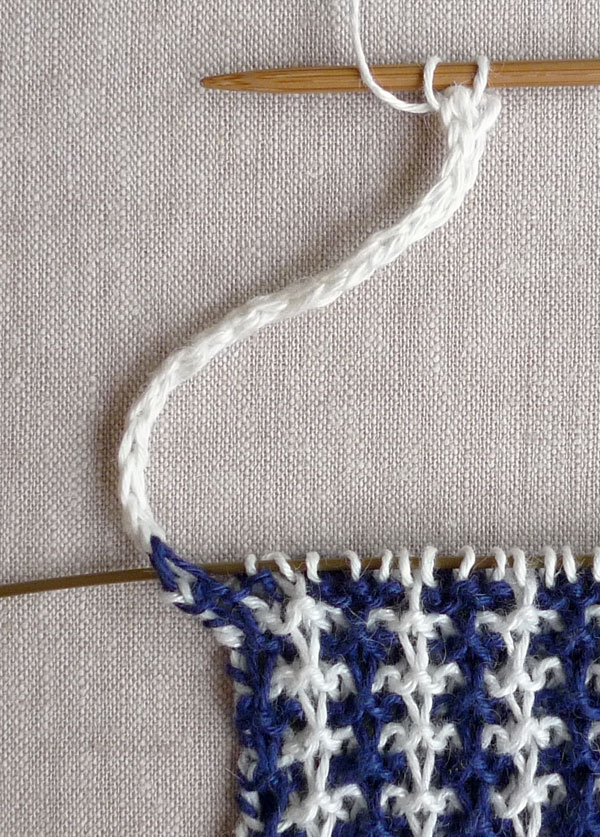
Now starting at the base of the 3-inch I-cord, work an Attached I-cord down the left selvage.
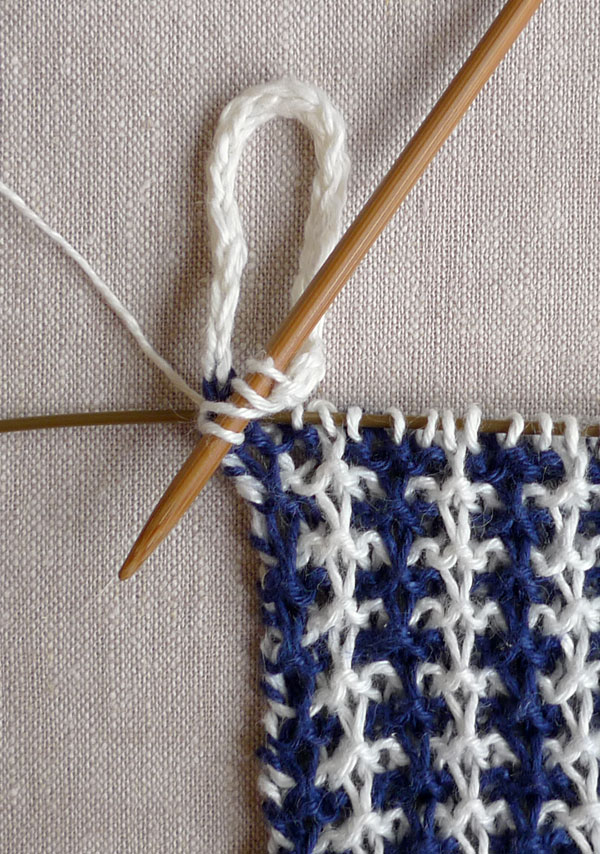
Pick up 1 stitch for every 4 rows (which means picking up 1 stitch at either every Color A or every Color C stripe) until you reach the bottom corner.
Pass the first stitch over the second, cut the yarn and pull it through the remaining stitch.
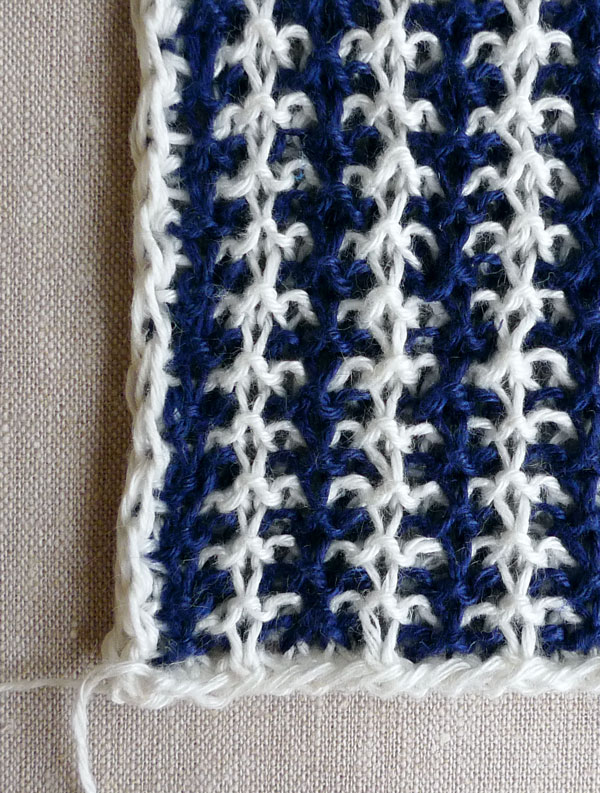
Now, with Color A, cast 2 stitches onto a double pointed needle.
K1, slip 1 wyib, yo and with right side facing, pick up a stitch in the bottom right corner.
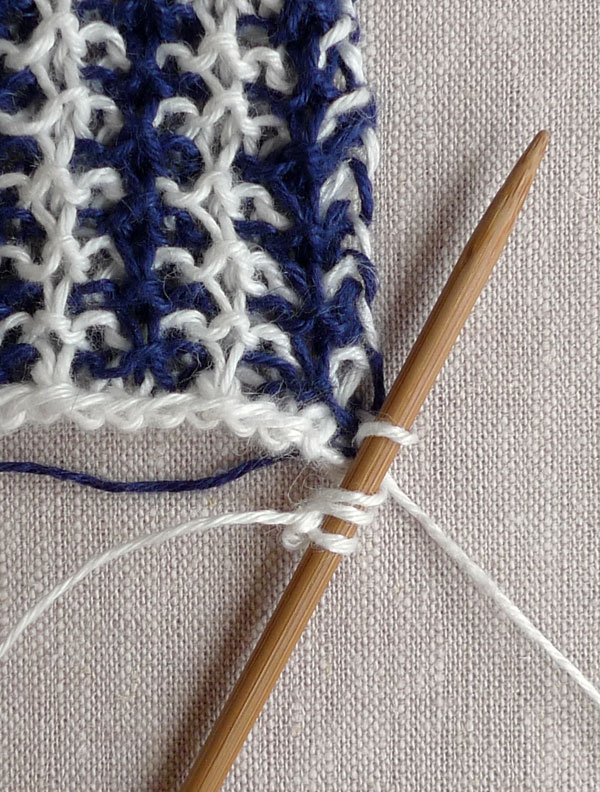
Work an Attached I-cord up the right selvage to the top corner.
Knit 1 row of a regular, unattached I-cord, then pass the first stitch over the second so that 1 stitch remains.
Using the double pointed needle with 1 stitch on it, knit the first stitch that is on the circular needle and bind off. Continue to bind off all the stitches that remain on the circular needle.
Cut the yarn and pass it through the remaining stitch.
Weave in the ends and block your new dishtowel!
Basket Stitch
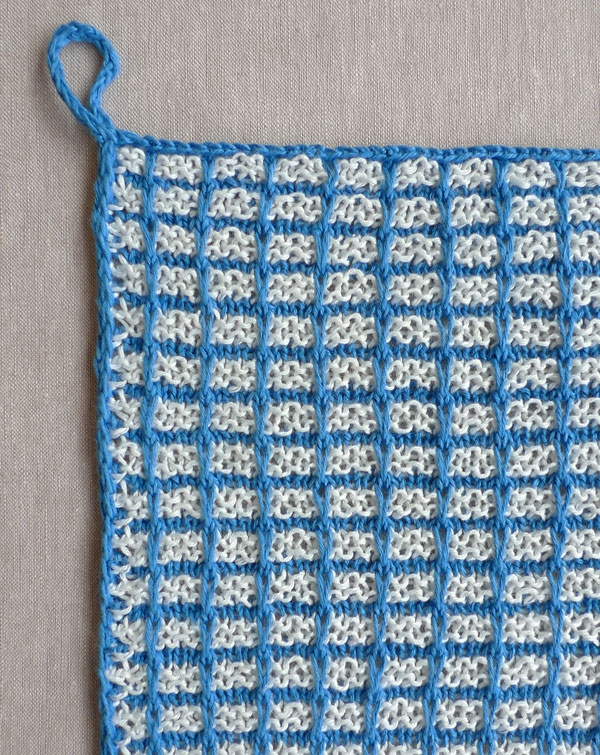
With Color B, cast on 71 stitches. We used a basic Long Tail Cast On.
Row 1 (wrong side): Purl.
Row 2 (right side): With Color A, k3, *slip 1 with yarn in back (wyib), k3, repeat from * to end of row.
Row 3: With Color A, slip 1 wyib, k2, *slip 1 with yarn in front (wyif), k3, repeat from * to end of row.
Rows 4 and 5: Repeat Rows 2 and 3.
Row 6: With Color B, knit.
Row 7: With Color B, slip 1 wyib, purl.
Repeat Rows 2 – 7 until piece measures 17 inches, ending with a Row 5.
Cut Color A.
Next Row (right side): With Color B, knit to last 2 stitches, k2 onto a double pointed needle.
Finish
Using Color B, follow the finishing instructions as for the Three-and-One Tweed, above, except, for this stitch pattern, pick up 2 stitches for every 6 rows (which means picking up 2 stitches at the Color A stripes and skipping the Color B stripes).
Triple L Tweed
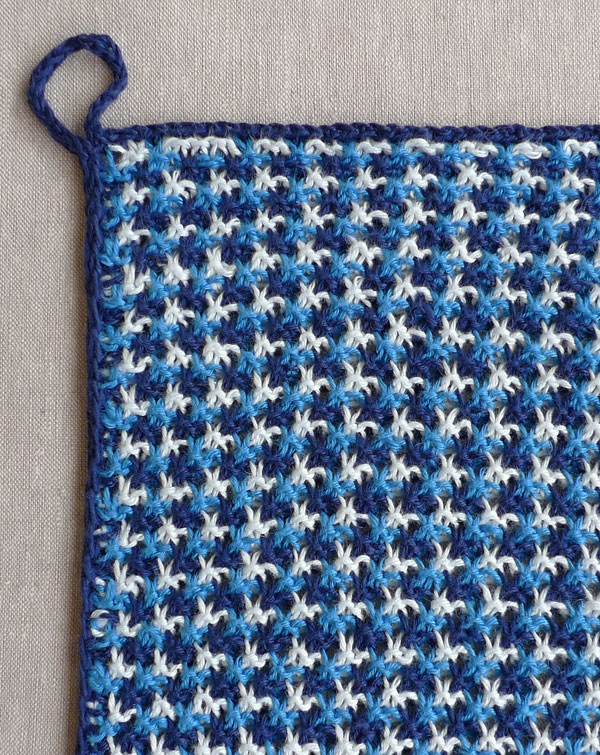
With Color C, cast on 76 stitches. We used a basic Long Tail Cast On.
Row 1 (wrong side): Purl.
Row 2 (right side): With Color B, k3, *slip 1 with yarn in back (wyib), k2, repeat from * to last stitch, k1.
Row 3: With Color B, slip 1 wyib, k2, *slip 1 with yarn in front (wyif), k2, repeat from * to last stitch, k1.
Row 4: With Color A, *k2, slip 1 wyib, repeat from * to last stitch, k1.
Row 5: With Color A, slip 1 wyib, *slip 1 wyif, k2, repeat from * to end of row.
Row 6: With Color C, k1, *slip 1 wyib, k2, repeat from * to end of row.
Row 7: With Color C, slip 1 wyib, k1, *slip 1 wyif, k2, repeat from * to last 2 stitches, slip 1 wyif, k1.
Repeat Rows 2 – 7 until piece measures 17 inches, ending with a Row 5.
Cut Colors A and B.
Next Row (right side): With Color C, knit to last 2 stitches, k2 onto a double pointed needle.
Finish
Using Color C, follow the finishing instructions as for the Three-and-One Tweed, above. Pick up 1 stitch for every 4 rows (which means picking up 1 stitch at every other stripe of color).
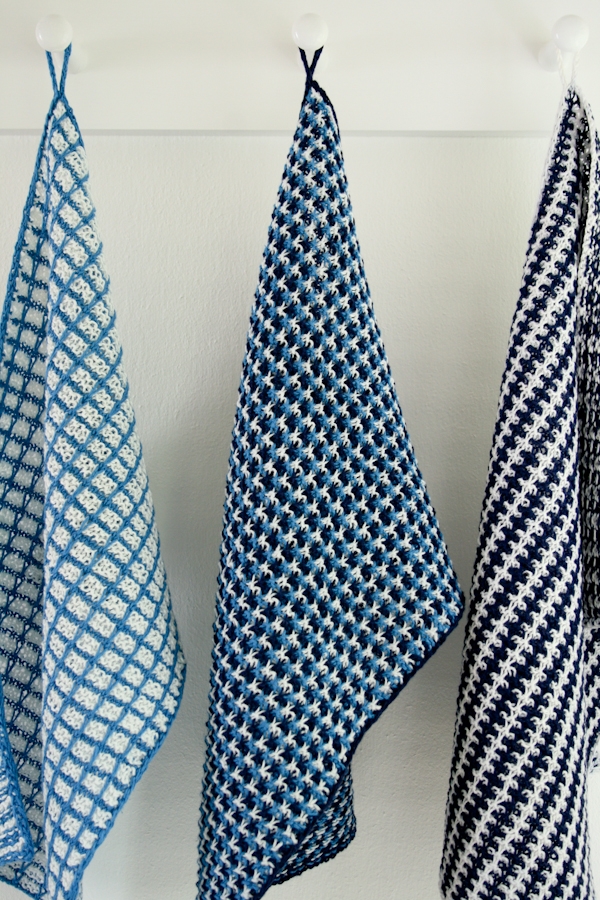

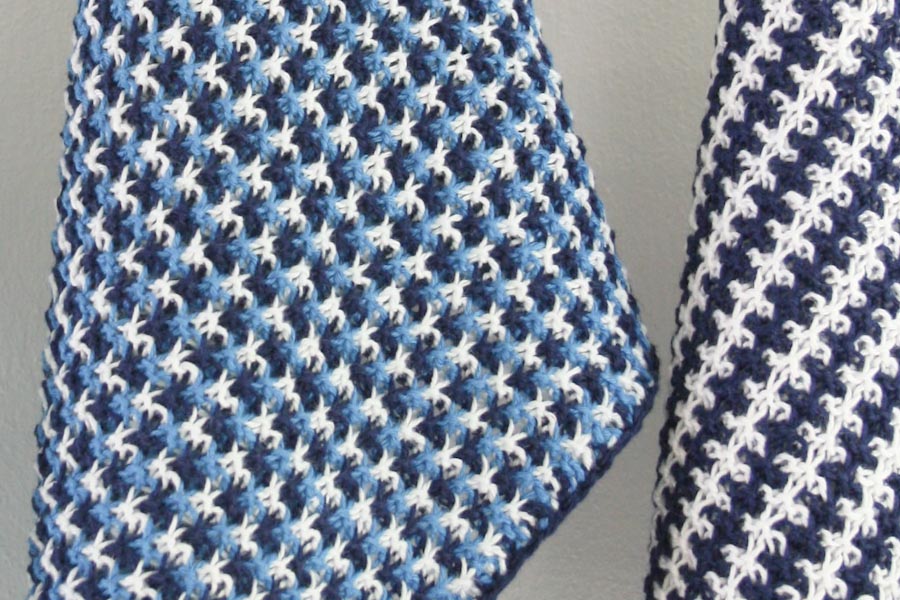
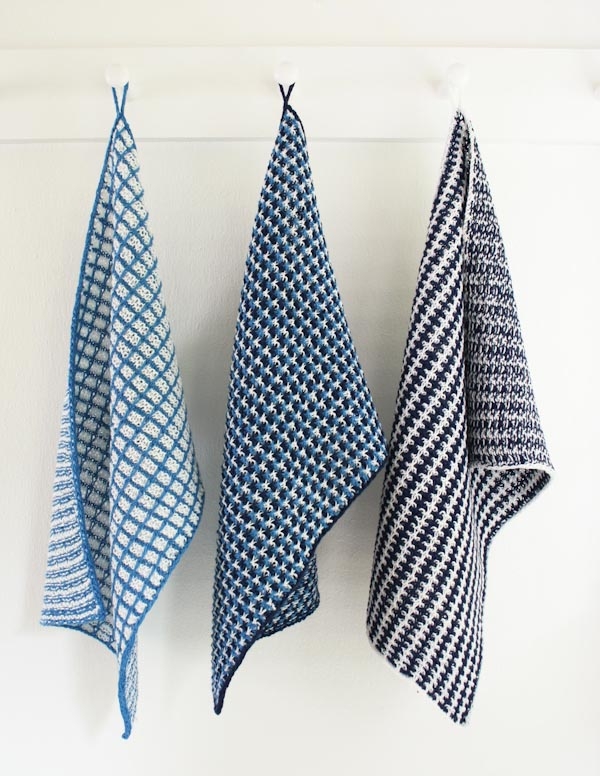
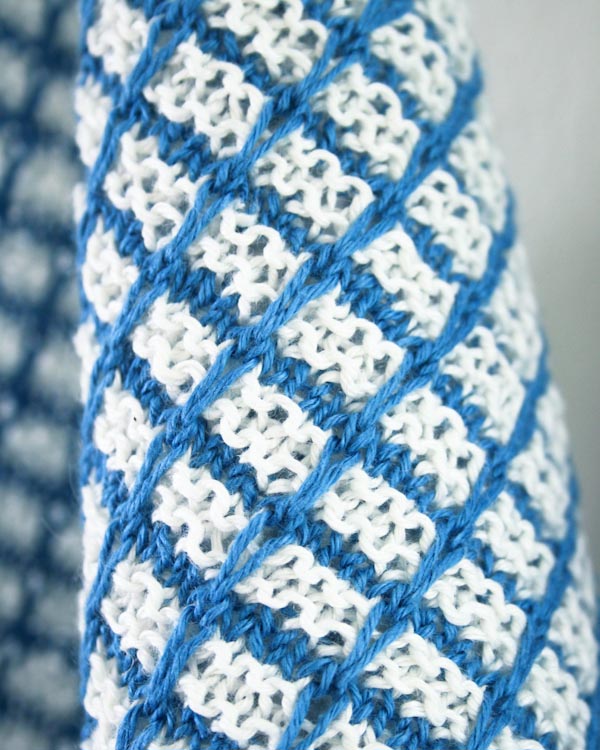
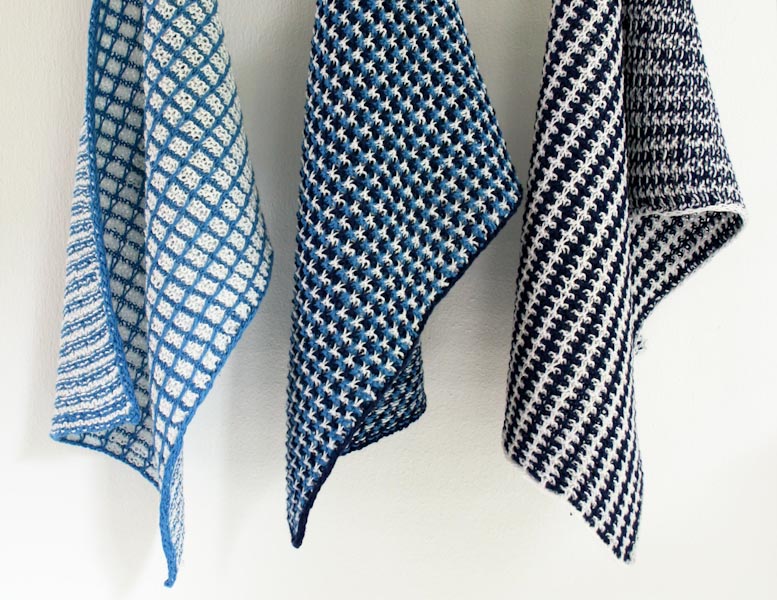
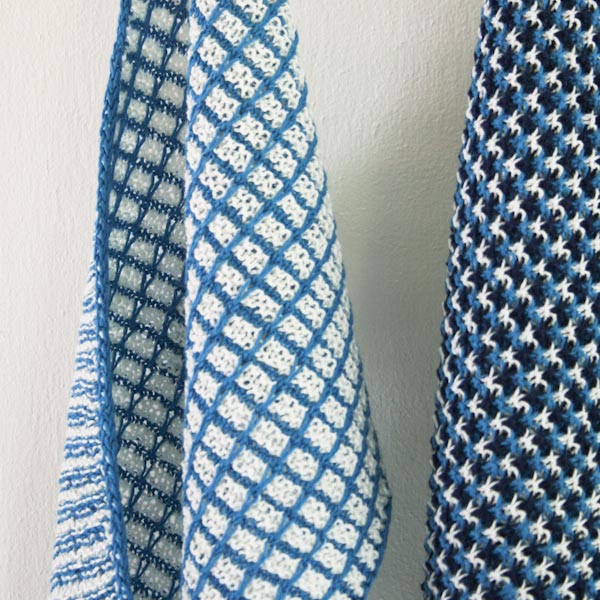
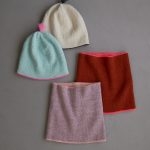
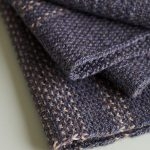
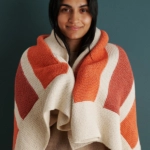
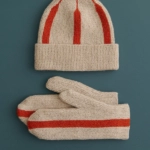
I want to make placemats in this design. How can I adapt this pattern for placemat size?
Thanks for your gorgeous web site!
Gill
Hello Gill,
Thank you for writing in and for your kind words! The first step in adapting this pattern would be to decide what size you would like your placemats to be. After you have decided on your measurements you will knit a gauge swatch to see how many stitches per inch you are getting. Once you have this information you can decide you your cast on number and then knit until it is the desired length.
When deciding on a cast on number you will want to note that the Three-and-One Tweed and the Basket Stitch, a multiple of 4 plus 3; and for the Triple L Tweed, a multiple of 3 plus 1.
I hope this helps!
Warmly,
Marilla
great!! I can hardly wait to get started! thanks a lot!
I am a fairly new knitter and have enjoyed this project so far. I am trying to finish the Triple L Tweed but I am really confused about the Icord and following K1, SLWYIB, YO sequence followed by an attached I cord. Basically the entire finishing section. Any suggestions?
Thank you
Meagon
Hi Meagon,
Thanks for writing in! I am sorry to hear that the finishing section is causing you difficulties. If you could clarify what type of problems you are having, I’d be happy to try to help you figure it out!
Best,
Cassy
I, too, do not understand the attached icord instructions. I was able to make the 3 inch icord. But I don’t understand the attached icord. It doesn’t seem similar to other attached icord instructions. Could you explain in more detail, perhaps getting us through 3 or 4 rows? Thanks.
Hello Nancy,
Thanks for reaching out! To do an attached I-cord with a two stitch cord you will do the following;
Knit 1, Slip 1 with yarn in back, Yarn over, pick up one stitch, then take the slipped stitch and the yarn over and pull both of those stitches over your picked up stitch and off the needle. Or cast off both the slipped stitch and yarn over over your picked up stitch.
You then slide your stitches to the other end of your dpn and start from the beginning again.
I hope this all makes sense and let us know if you have any further questions!
Warmly,
Marilla
i am referring to the finishing of the slip stitch dishtowels.
i have made my 3 ” icord, but my confusion comes with the next instructions after finishing the icord, it states work to last row as k1 slip 1 wyib, yo
it doesn’t indicate cutting the yarn, it would make sense to me to join the icord and start the icord down the left side of the f ront of the towel. so my confusion, how do i knit that row, my yarn will be on the other side, wow what am i missing
Hi Linda,
Thanks for writing in! After finishing the last row of the i-cord, your yarn should be at the left end of the double-pointed needle, so you’re all ready to start the attached i-cord by picking up a stitch at the top of the left-hand edge of the dishtowel. If you take a look at our pictures for this step, you can see that you have to rotate your needle slightly from horizontal to vertical so it is pointing the same direction as the edge of the towel that you will be picking up stitches from.
I hope that clears things up!
Julianna
May I suggest that you put this set of directions in the body of the pattern? It feels like the directions that the links take one to are not relevant for the 2-stitch version of the i-cord. This small paragraph is very clear!
K1, S1WYB, YO, pick up 1; pass slipped stitch and YO over the picked up stitch; repeat.
I’m having trouble with the I-cord on the basket and triple tweed patterns. When I pick up a stitch that’s a different color from the I-cord that color shows up in the I-cord, since the picked up stitch becomes the slipped stitch in the next row. But when I look at the pictures in the pattern all the I-cords are a solid color. Am I doing something wrong? How do you pick up a stitch of a different color without it showing up in the I-cord?
Hi Meaghan,
We’re so sorry to hear you’re having trouble with the I-cord for these dishtowels! We’d love to see a photo of your work so we can better help with this step. Please feel free to send over a photo to customerservice@purlsoho.com and we can help you from there!
All the best,
Margaret
I am a fairly new knitter and do you have a visual tutorial for changing colors multiple times when knitting an item?
Hello Pam,
Thanks for writing in! Other than the photos on this page we do not currently have any visual tutorials for these stitches. Is there a particular part of this pattern that you are stuck on? I hope I can help!
Warmly,
-Marilla
I love this bundle of colors and the pattern.
What would be the math if I wanted to make these slightly smaller.
I see you cast on 75. Would the pattern work if I casted on 50?
Thank you!
Hello Shirley,
Thank you for your question! When deciding on a cast on number you will want to note that the Three-and-One Tweed and the Basket Stitch, a multiple of 4 plus 3; and for the Triple L Tweed, a multiple of 3 plus 1.
So if you want to knit the Three-and-one Tweed I would cast on 51 (4 x 12 + 3 = 51).
I hope this helps!
-Marilla
I am wondering — if you have blocked your dishtowel after you have finished knitting it, do you then also need to block it each time you wash it? Should you line-dry it?
Thanks.
Hi Kitty,
Thanks for writing in! We did block these lovely dishtowels! You can put Euroflax in the washer AND dryer. If you do, it just get softer and softer! As to whether you will need to block them each time, I would not think so. Washing and drying them should result in them looking just fine!
Best,
Cassy
Does anyone besides me have great difficulties printing your free patterns? They always seem to print extra text, on top of the parttI really want to print. I don’t want to print everyone’s comments… just the pattern, please.
Hi Chris,
Thanks for writing in! We have a print function that will allow you to print as little or as much as you would like in the way of photos and the patterns.
If you’re on a desktop version of the site, you will find a “print” icon in the right column just below the date and tags. If you’re on a mobile version of the site, you will find a “print” icon below the pattern and above the comments.
Follow the easy on-screen instructions to delete whichever parts of the pattern you don’t want to print or save. For example, you may decide to shorten the pattern by omitting certain images or the list of materials.
I hope that this helps!
Cassy
Is there an option to print without photos?
It’s an awful lot of paper for a simple set of towels.
Thanks
Hi Cecelia,
Thanks for writing in! We certainly do have a print option that will allow you to print as little or as much as you would like. If you’re on a desktop version of the site, you will find a “print” icon in the right column just below the date and tags. If you’re on a mobile version of the site, you will find a “print” icon below the pattern and above the comments.
Follow the easy on-screen instructions to delete whichever parts of the pattern you don’t want to print or save. For example, you may decide to shorten the pattern by omitting certain images or the list of materials.
Best,
Cassy
But I à ma question about your paterns ,havé you french patterns for your betterave diswasher cloth .I am not Easy to work in english
Thank you for your service ,you have spécial
Knitting work,
Paulette J
Hi Paulette,
Malheureusement, nous avons seulement les patterns en anglais. Merci pour votre demande!
Bien à vous,
Cassy
I have the same question as Meagon from 7/24/2017.
I am trying to finish the Triple L Tweed but I am really confused about the Icord and following K1, SLWYIB, YO sequence followed by an attached I cord.
Do I do the K1, S1WYIB and YO with the two stitches?
Hi Alison,
Thanks for writing in! You will work the K1, S1WYIB and YO with the two stitches of the i-cord. This will feel a touch weird as you are working the YO with no stitch after it. Just hold the YO in place and starting at the base of the 3-inch I-cord, work an Attached I-cord down the left selvage. The picture below the K1, SLWYIB, YO instruction should give you an idea of how you will hold these stitches and insert the needle into the base of the i-cord to begin working the attached i-cord.
I hope that this helps!
Cassy
Have you any hints on working out the chart or written pattern if you have a picture of a finished item?
I can chart what it “looks like” and understand I think about repast plus some, about knitting forward from the pattern/chart and working back according the what the sts on the needle tell you, but despite having knotted two other squares in mosaic from Rowan KAL thru Martin Storey I am not doing well.
It don’t think its yarn and needle size issues.
AAAAAAAAAAAAAAAAA
ABBBABBBABBBABBBA
ABABABABABABABABA
ABBBBBBBABBBBBBBA
AAABABAAAAABABAAA
ABBBBBBBABBBBBBBA
ABABABABABABABABA
ABBBABBBABBBABBBA
AAAAAAAAAAAAAAAAA
This should graph as a quadrifoil with centre hub each 3×3 with a single centre stitch. with horizontal and vert boundaries and little arms nudging into the spaces. I have seen it as a finished item but not as a chart or written instructions. I sketched it with the wearers permission, we did not share a language, and I have no photo.
Hope you can help. It maybe to knit it it need the underlying core grid to be 4×4 not 3×3?
Thanks in hope M
Hi Mary,
What a project! At present we do not have any tutorials that I can point you to for charting a pattern from a finished item. There are some books that I find helpful when designing sweaters and stitch patterns. Barbara Walker’s excellent stitch dictionaries contain a wealth of written stitch patterns from the simple to the very complex. And Ann Budd’s books are always a go to for basic pattern and pattern construction!
I am sorry that we could not be of further help! Best of luck on your project!
Cassy
I would like to make a baby blanket with this yarn and he basket pattern. Can you suggest a cast-on number of sts or what the multiple is for calculating that? Also the yardage for 2 colors?
Thanks,
love your store, your yarns
Hi Dale,
Thanks for writing in! What a great idea! This would make a lovely blanket! The Basket Stitch pattern works over a multiple of 4 stitches plus 3 stitches. For this particular pattern we used roughly half of each of 2 skeins of yarn for a 11 1/4 x 17 1/4 inch dishcloth. So if you would like to make a blanket that is 34 x 22 inches, you will need 2 skeins of each color. If you would like to make your blanket larger, we would be happy to help you figure out the correct yardage!
Best,
Cassy
I am a fairly new knitter. I would like to try these dishtowels but not sure which needles to purchase. Which length of circular needles would you recommend? And bamboo or metal?
thanks,
Lauren
Hi Lauren,
Thanks for writing in! What a lovely project to try! I would suggest 20 or 24 inch needles for this project would probably work best! As to bamboo or metal, that is very much a personal preference. I will say that metal needles can be a bit more slippery than wood. I generally prefer metal but when working with linen, which can be more slippery than wool, I tend to use bamboo as it grabs onto the linen and helps you keep the work on the needles. However, this is just personal preference and you may find that you prefer one over the other. Both will work well here!
I hope that this helps!
Cassy
I love these dish towels! I have a question about the attached I-cord sides. I have done one side so far and it seemed to be so tight that it kind of shortened the length of that side of the towel, I even changed to a larger size dpn (which did seem to help a little) … I hope that makes sense. Is this normal or should i try something different? Thank you!!
Hi Niki!
Thanks for writing in! It seems like your tension might be a little tight for the I-cord edging. I would continue sizing up your needles until you find a size that loosens up your gauge!
Best,
Carly
I was thinking of using all my remnants of cotton wool to make a towel. Over the years I made many dishcloths and I have lots of leftover wool.
I love your patterns for these dish towels.
Hello!
These dish towels are so beautiful! Would this pattern and yarn work as a set of dishcloths (for washing/scrubbing dishes, etc).
Hello Samantha,
Thank you for writing us! Yes, I think this would work great as a set of dishcloths.
Happy knitting!
-Marilla
I love the slip stitch towel look. However, I never found the pattern. Went to said website. Just a lot of talk about the towel and tips., just no pattern.
Hi Susie,
Thanks for reaching out! I am sorry to hear that you are having difficulty! The patterns for these lovely dishtowels are located on the top portion of this page! If you would like to print them out, you can do so using out handy print function! If you’re on a desktop version of the site, you will find a “print” icon in the right column just below the date and tags. If you’re on a mobile version of the site, you will find a “print” icon below the pattern and above the comments.
Follow the easy on-screen instructions to delete whichever parts of the pattern you don’t want to print or save. For example, you may decide to shorten the pattern by omitting certain images or the list of materials. To remove images, click the drop down next to the image icon and change from 100% to 0%.
Best,
Cassy
I don’t understand when I add a color, what to do with the old color. Do I carry it along in the row? Leave it and pick it up at another time? I need some pretty basic help! Thanks
Hello Nancy,
Thank you for reaching out! For these lovely dishtowels you will be carrying your yarn up as you go.
I hope this clarifies things for you and let us know if you have any further questions!
Warmly,
Marilla
I’m new to knitting and learning the stitches before I tackle a sweater. When adding in the different colored yarns, do I have to keep cutting them? That confuses me because I’ve been practicing on dish cloths but not a very desirable outcome. 🙁
Hello Susan,
Thank you for reaching out- this sounds like a great idea! You do not cut the yarn, but rather carry the yarn up along the edge of your knitting. When changing colors, carry the new yarn up the selvedge in front of the old yarn. In this photo the Navy yarn is the “new yarn” about to knit the first stitch. Above, in the pattern, is a photo that illustrates what this looks like.
I hope this helps and let us know if you have any further questions.
Happy knitting!
-Marilla
Hi,
I’d like to make these towels in a smaller size. Could you tell me what multiples you use for each of them so I know what number of stitches to cast on, but keep true to the pattern. I’m afraid I’m having a hard time working it out from the patterns.
These are the cast on stitches as is:
Triple L tweed, 76 stitches
Three in one 75 stitches
Basket stitch 71
Thank you SO much.
Hi Kathy,
Thanks for reaching out! For the Three-and-One Tweed and Basket Stitch patterns you will need to cast on a multiple of 4 plus 3, and for the Triple L Tweed, a multiple of 3 plus 1.
Happy knitting!
Julianna
Hello! The Eurflax link is broken: https://www.purlsoho.com/euroflax.html. I am a knitting newbie and would really like to try these towels but don’t know what yarn to get. Can you advise? Thanks!
Hi Sara,
Thanks for reaching out! Unfortunately we no longer carry Euroflax, which is why the link is no longer working. However, our Field Linen would be an excellent yarn to substitute for these dishtowels! It knits up to just about the same gauge as Euroflax but has a bit more yardage, so you will need the same number of skeins.
Best,
Julianna
I made these towels a few years ago and I want to make again, but wider and longer, 17 x 30. What yarn would you suggest? I would like to make all three patterns in warm tone colors with neutral.
Hi Jocelyn,
Take a look at our Cotton Pure! This yarn is perfect for towels with many great colors!
Hope this helps!
Oscar
I’m a semi-beginner knitter and I’m finishing my first farmhouse dish towel and I’ve not done this kind of bind-off – or maybe I’m just unfamiliar- but is there a YouTube video… or maybe a different name I could google to walk me through it?
…. Specifically it’s the [k1, slip first st over] 3 times.
I love the towel!!! Can’t wait to try more of them!!!
Hi Jackie,
Thanks for reaching out! The bind-off for the Farmhouse Dishtowels doesn’t have a specific name since it is unique to that pattern, and unfortunately, we don’t have a tutorial for it. But luckily it is simply a Basic Bind-Off method with a few alterations to accommodate the established stitch pattern of the dishtowels!
So you will work it just as you do any bind off, starting with a knit 1, then knit another 1 (2 stitches on your right needle) you will then pass the first stitch over the 2nd stitch to bind it off (just as we do in the basic bind off tutorial) you will so this a total of 3 times. You should have one stitch left on the right needle when you complete this. Then you will change it up a bit by p1, the pass the first stitch on your right needle over. You will then start the process over repeat from * to last 4 stitches, [k1, slip the first stitch over] two more times, then k2, leaving 3 stitches on the right needle.
So really, it is no different than the classic bind off, you’re just working in different multiples and including purl stitches to maintain the stitch pattern!
I hope this clears things up and please let me know if you have any more questions!
Gianna
Can you do a continental stitch by it self?
Hi Debra,
Thanks for reaching out! I’m not quite sure I understand your question though. Would you be able to provide a little bit more context?
All the best,
Lili
I have always done moss stitch for dishcloths. I would like to try your stitch pattern. I only want to cast about 30 to 32 or so st. how can I adapt? Thank you!
Hi Claudia,
So happy to hear you are interested in making the Slip Stitch Dishtowels, I have had my eye on these too! To get an idea of how you will adjust the pattern, you will want to start by making a gauge swatch. Once you do that, you will measure how many stitches you have per inch. With that number, you can multiply by the desired width for your dishtowel and you will get your cast on number.
One thing to keep in mind when deciding on a cast on number, you will want to make sure that for the Three-and-One Tweed and the Basket Stitch, you are starting with multiples of 4 plus 3; and for the Triple L Tweed, a multiple of 3 plus 1. I hope this helps!
Happy knitting,
Gavriella